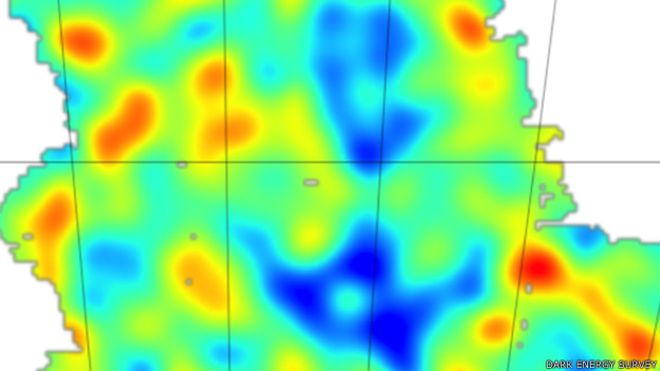Mapping the cosmos: Dark Energy Survey creates detailed guide to spotting dark matter [NOT TRANSLATED]

– Scientists at Institut de Ciències de l’Espai (IEEC-CSIC) participate in the study.
Scientists on the Dark Energy Survey have released the first in a series of dark matter maps of the cosmos.. These maps, created with one of the world’s most powerful digital cameras, are the largest ever created at this level of detail, and will improve our understanding of dark matter’s role in the creation of galaxies.
The new maps were released at the April meeting of the American Physical Society in Baltimore, Maryland. They were created using data captured by the Dark Energy Camera, a 570-megapixel imaging device that is the primary instrument for the Dark Energy Survey (DES).
Dark matter, the mysterious substance that makes up roughly a quarter of the universe, is invisible to even the most sensitive astronomical instruments because it does not emit or block light. But its effects can be seen using a technique called gravitational lensing – studying the distortion that occurs when the gravitational pull of dark matter bends light around distant galaxies.
This analysis was led by Vinu Vikram of Argonne National Laboratory (then at the University of Pennsylvania) and Chihway Chang of the Swiss Federal Institute of Technology in Zurich. Vikram, Chang and their collaborators at Penn, Zurich, the University of Portsmouth, the University of Manchester and other DES institutions worked for more than a year to carefully validate the lensing maps.
“We measured the barely perceptible distortions in the shapes of about two million galaxies to construct these new maps,” said Vikram. “They are a testament not only to the sensitivity of the Dark Energy Camera, but also to the rigorous work by our lensing team to understand its sensitivity so well that we can get exacting results from it.”
The camera was constructed and tested at the U.S. Department of Energy’s Fermi National Accelerator Laboratory, and is now mounted on the 4-meter Victor M. Blanco telescope at the National Optical Astronomy Observatory’s Cerro Tololo Inter-American Observatory in Chile. The data were processed at the National Center for Supercomputing Applications at the University of Illinois in Urbana-Champaign.
The dark matter maps released today make use of early DES observations and cover only about three percent of the area of sky DES will document over its five-year mission. The survey has just completed its second year. As scientists expand their search, they’ll be able to better test current cosmological theories by comparing the amounts of dark and visible matter. Analysis of the clumpiness of the dark matter in the maps will also allow us to probe the nature of the mysterious dark energy, believed to be causing the expansion of the universe to speed up.
Those theories suggest that, since there is much more dark matter in the universe than visible matter, galaxies will form where there are large concentrations of dark matter (and hence stronger gravity) present. So far, the DES analysis backs this up: the maps show large filaments of matter along which visible galaxies and galaxy clusters lie and holes in the dark matter where fewer galaxies reside. Follow-up studies of some of the enormous filaments and voids, and the enormous volume of data, collected throughout the survey will reveal more about this interplay of mass and light.
“Our analysis so far is in line with what the current picture of the universe predicts,” said Chang. “Zooming into the maps, we have measured how dark matter envelops galaxies of different types, and how together they evolves over cosmic time. We are eager to use the new data coming in to make much stricter tests of theoretical models.”
_________________
The Dark Energy Survey is a collaboration of more than 300 scientists from 25 institutions in six countries. Its primary instrument, the Dark Energy Camera, is mounted on the 4-meter Blanco telescope at the National Optical Astronomy Observatory’s Cerro Tololo Inter-American Observatory in Chile, and its data is processed at the National Center for Supercomputing Applications at the University of Illinois at Urbana-Champaign. [NOT TRANSLATED]
